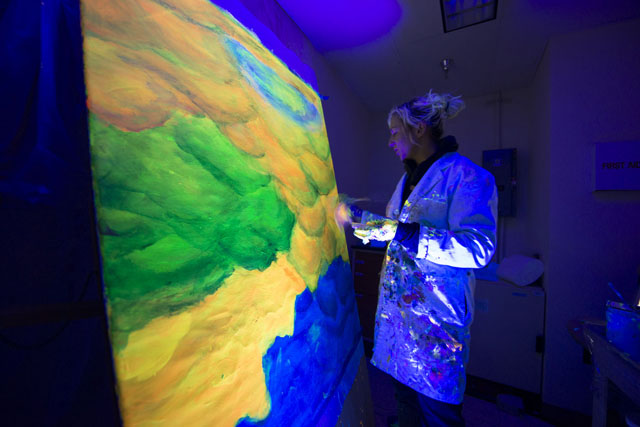Page 2/2 - Posted June 29, 2015
Simonson adds landscape paintings to her repertoireUnfortunately, the on-Ice collaboration never happened. However, while still working toward that goal, Simonson was in Portland, Ore., with Thurber in 2012 to talk about the interconnections between art and science at an Antarctic-themed conference. Permafrost geologist Joe Levy, now a research associate at the University of Texas’ Institute for Geophysics, saw Simonson’s name on a poster at the symposium. He knew a Lily Simonson back in high school. Levy contacted her, they caught up as old high school friends do, and then he made an intriguing offer of his own to join him in the McMurdo Dry Valleys, a desert ecosystem where he studies the interplay between ice, water and land morphology. By then, Simonson was already deep into the process of putting together her own proposal to the NSF to dive in Antarctica. However, she accepted Levy’s invitation, accompanying his field team in 2012-13 to the stark but stunning Dry Valleys, which are often described as being the closest thing to Mars on planet Earth. The wide expanse of dusty beige across the valley floors and the massive pearl-white glaciers that pour over the valley walls like slow-melting ice cream were like nothing she had painted before. Previously, her goal was to glorify the little guy, magnifying the tiniest invertebrates to monster scale. “It’s almost the opposite. I’m trying to capture the vastness and shrink it down to a painting. It’s an interesting problem,” says the 33-year-old artist. “I felt like I was walking into an abstract painting. You have dimensionality all around you, but there’s nothing familiar here, there’s no plant life, there’s just lots and lots of space.” The result was her second solo show at CB1 Gallery, in Los Angeles, called On Ice. The exhibit included both abstract paintings and the key feature in Garwood Valley, a buried glacier that has been exposed in the valley wall. She used ultraviolet-reactive pigments to bring out the luminosity of the landscape. “Only a monumental painting is going to capture Antarctica in any way, and I think Lily’s work is better than any snapshot, is better than any photo,” Levy says. “It’s good for science to have this fresh set of eyes that says what’s important about your site, what’s changing about your site, and how can it be captured and expressed,” he adds. “That’s why it’s so great that NSF has the Artists and Writers Program.” That trip two years ago only whetted her appetite for all things Antarctic. Simonson learned to dive in a dry suit, and finally applied to the NSF Artists and Writers Program. Her selection for the 2014-15 season included a return visit to the Dry Valleys with Levy, as well as diving under the sea ice to collect invertebrates for what will undoubtedly become a series on polar marine life. A visit to active Erebus volcano – in a region shaped by volcanism – added to the richness of her experience – one that she hopes to bring to an even wider audience in the future. “I think it makes the art and the science more accessible when we have this confluence,” Simonson says of her ongoing collaborations with Levy and other scientists. “It gives the art a certain narrative and something for people to learn about, and that’s exciting. When humanities people see that an artist is embedding with science groups, it makes the science itself seem more accessible.” NSF-supported research in this article: Lily Simonson, Award No. 1344504 |
"News about the USAP, the Ice, and the People"



For USAP Participants |
For The Public |
For Researchers and EducatorsContact UsU.S. National Science FoundationOffice of Polar Programs Geosciences Directorate 2415 Eisenhower Avenue, Suite W7100 Alexandria, VA 22314 Sign up for the NSF Office of Polar Programs newsletter and events. Feedback Form |




